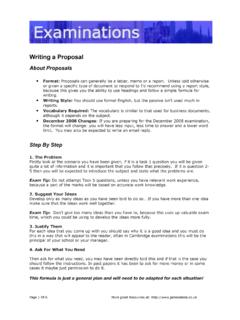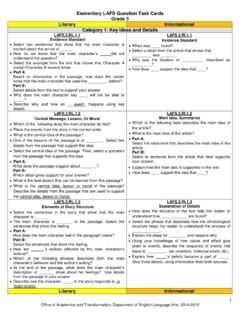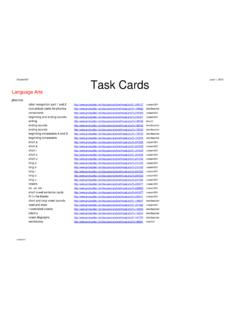Transcription of Writing Progress notes 6-25-07 - NIATx: Home
1 Updated on 6/29/07, developed by David Loveland, Fayette Companies ( ) 1 Documenting Services Delivered in Behavioral Health Programs: Writing Progress notes Writing Progress notes is perhaps the most common documentation activity performed by direct service providers. There are two primary functions of a Progress note. The first function or purpose of a Progress note is to record services provided by a staff member. Progress notes are the primary source of data indicating that a service was delivered. The second function of a Progress note is to document the course of treatment; , Progress or lack thereof related to a treatment intervention. Both functions of the Progress note are essential elements of evidence-based practices. Both functions are described below. Documenting Service Delivery Documenting services delivered is an important and interrelated component of any treatment intervention. The documentation process is based on and rooted in the original treatment plan and goals of the intervention.
2 All contacts with consumers/clients are logically connected to a proactive intervention (including crisis-based contacts). The documentation process is an easy task to complete if the direct service provider is recording an activity that was planned in advance and linked to an appropriate treatment program or intervention. Therefore, effective documentation of services begins long before the service is delivered. Good Progress notes begin with effective treatment planning. If more work is given to the proactive development of an effective treatment intervention, less work will be needed in documenting those services. In essence, thorough and comprehensive treatment planning leads to easy documentation in Progress notes , whereas poorly developed treatment planning leads to extensive documentation in Progress notes (or worse, incomplete or unclear documentation of services). There are several principles of evidence-based practices that influence the structure of Progress notes .
3 These principles include: A. Collaborative relationship. All evidence-based interventions in mental health and addiction treatment are based on a collaborative relationship between an individual with an identified need ( , help overcoming a substance use disorder, depression, or related issues, such as assistance finding a job) and a direct service provider ( , addiction counselor, recovery coach, case manager, or job coach) or team of providers. This principle implies that the two individuals work together to solve problems, achieve goals, and overcome barriers to goals. B. Person centered planning. A related principle to the collaborative relationship is a focus on person-centered planning. Person-centered planning implies that the consumer/client is given control over his or her treatment and that all treatment interventions are selected to help this individual achieve self-defined goals. This principle also implies that direct service providers are consultants working with individuals, rather than experts with the authority to select interventions without partnering with clients/consumers.
4 C. Goal directed services. All evidence-based interventions are designed to achieve specific outcomes or treatment goals. Evidence-based interventions are usually manualized, highly structured, and based on a set of guidelines. Even if an intervention is not designated as an evidence-based intervention, such as case management or peer-driven services, it is still being used to accomplish a goal. This implies that a goal needs to be identified in order to provide services. Stated another way, services are not provided when a goal has not been identified. Updated on 6/29/07, developed by David Loveland, Fayette Companies ( ) 2 D. Measurable and reasonable goals. This principle indicates that the goals-outcomes (short- & long-term) selected by consumers and direct service providers need to be observable, measurable, within the individual s capacity ( , reasonable), & logically connected to the intervention being implied. This principle also implies that direct service providers and consumers need to avoid selecting goals/outcomes that are difficult to observe, measure, or beyond the capacity of the individual.
5 These four principles are used as guides for Writing Progress notes . In addition, there are four types of service contacts that can occur between a direct service provider and consumer/client. The four types of contacts include: (1) Engagement & treatment planning. This is usually the first activity that occurs between a direct service provider and consumer/client (crisis contacts occasionally occur before this activity). This activity occurs before any treatment intervention has been established or delivered and can reoccur over time (at least the treatment plan development part). Treatment plan development can include monitoring behaviors to establish a baseline rate for a particular target behavior. Engagement is an individualized process, but it is not an unlimited activity. If direct service providers are unable to engage individuals within a reasonable amount of time ( , 4 to 8 weeks in a community-based model), change the plan or service provider.
6 (2) Service delivery. After a working relationship has been developed and a treatment plan has been established, the next logical series of service contacts are activities associated with a particular treatment intervention. Frequency, intensity, and duration of contacts are based on consumer preference and the particular intervention that is being used. (3) Closure or transition. All effective or evidence-based interventions have a beginning and an end-point. Closure activities are used to praise individuals for completing a particularly treatment intervention as well as achieving a planned goal, and helping them to either move on to the next goal or close services. If the intervention does not have an end-point, it cannot be evaluated. If an intervention cannot be evaluated, it s probably ineffective or, worse, detrimental to the client/consumer. Transitioning activities can also be used to end an intervention that has shown to be ineffective and modify the treatment plan to try another technique.
7 (4) Crisis-based interactions. Crisis-based contacts are, by default, unplanned or unpredicted contacts outside the established treatment plan. In addition, to meet the criteria of crisis , the individual will require assistance that cannot be delayed or diverted. Many direct service providers erroneously label predicted or expected behaviors as a crisis. Most crisis events are actually predictable events that were not addressed in the treatment planning process. For example, a relapse of alcohol or other drugs for an individual who recently completed addiction treatment is not unexpected. In addition, if a behavior occurs frequently (more than two or three times), it is, by default, not a crisis, but rather a predictable behavior that requires an intervention. Most of these mislabeled events will probably fall under the first activity of treatment plan development ( , need to revise plan to address ongoing behavior) or service delivery ( , relapse prevention or planned assertive outreach due to a relapse).
8 The four principles of evidence-based practices combined with the four types of service activities provide the structure for Writing a Progress note documenting that a service was delivered. One additional element is the application of the 3 Ws (who, where, & when). All Updated on 6/29/07, developed by David Loveland, Fayette Companies ( ) 3 Progress notes begin with a list of individuals involved in the activity, where the activity occurred, and when (include the total amount of time involved in the activity). Table 1 displays a grid for organizing Progress notes . Each row represents an activity and each column represents elements of the Progress note. Each activity requires a note regarding each element. Table 1: Structure of a Progress Note Activity Who, Where, & When Purpose of activity Expected goal of activity Evaluation of activity Follow-up appointment Engagement and treatment planning Clearly state how engagement or treatment planning occurred.
9 Also, list any tools or surveys used in the engagement or treatment planning process. State the goal up front, even if the client does not have a goal, the direct service provider should have a goal for meeting with the client Follow-up appointment achieved, treatment plan has been written (or a part of it), behavior has been observed, data collection of behavior will continue Provide a date for follow-up and who will be involved in the next meeting, briefly summarize treatment plan and where the plan can be found Service delivery Note specific treatment plan goal or step. All interventions need to be linked to a treatment plan intervention or step (numbers can be used) Goal needs to be measurable and will change at every contact. State the goal up front, even if the client does not achieve the goal Achieved, partially achieved, did not achieve. If not achieved, please explain what happened and what will change Provide a date for follow-up and who will be involved in the next meeting Closer/ transition Summarize why the treatment intervention has been completed or terminated The goal is to summarize the treatment ending or why another treatment intervention will be provided Closer is understood or transition is understood List referral plan and that referring agency has been contacted Crisis-management Name of client, name of staff person, & name of other individuals involved, Clearly state location Note the beginning time and ending time and total time Only used if behavior has not been observed in the past.
10 Describe the crisis in clear terms and avoid vague or ambiguous language ( , client was acting crazy) Clearly state how crisis was addressed and provide, if possible, a functional analysis of how the crisis was initiated Has the crisis state been resolved? Follow-up should be clear, responsibility assigned, and soon after the event. Behavior associated with the event should be addressed in a new treatment intervention Updated on 6/29/07, developed by David Loveland, Fayette Companies ( ) 4 Documenting Progress of Treatment The second function of a Progress note is to document Progress associated with a treatment intervention. Progress is noted in Table 1 under the evaluation of the activity. Evaluating the outcome of the activity requires minimal effort and Writing when delivering a well developed treatment intervention. On the other hand, a poorly developed treatment intervention will lead to an increase in effort, time, and Writing in order to evaluate an activity.









